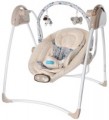Type
— Rocker. The distinctive feature of rockers as a type of swings is the adjustable backrest, which can be raised from lying to sitting position. The seat itself can be either adjustable or non-adjustable in tilt, but in any case the backrest and seat are adjusted separately. Rocker models can be used both for newborns and for older babies who are able to sit up on their own.
—
Bouncer. Chair bouncers differ first of all in that they do not have an adjustable backrest: only the tilt angle of the whole unit (backrest+seat) can be changed, and the unit itself is designed for lying down position of the child only. Thanks to the latter, all bouncers can be used from the first days of the baby's life; on the other hand, when the baby grows up and can sit up independently, the bouncer may not be so convenient.
—
Swing. Designs similar to classic children's swings: the seat unit is attached to a fixed stand and can swing back and forth thanks to movable fasteners (unlike other types that swing on curved skids, like classic rocking chairs). The advantage of the swing is the immobility of the base — they can be placed on any surface without fear of damaging it. On the other hand, swings take up significantly more space than other types. At the same time, there are models in which the seat unit can be removed and used separately as a rocking chair or bouncer (see above).
Age group
—
From birth. The possibility of use for newborns is provided in most modern swings, regardless of the type (see above). Such models necessarily provide for the possibility of lying down, because in the first months of life the baby's spine is not yet adapted to a long stay in an upright position.
—
From 6 months. Swings designed for children aged six months or more, who are already able to sit on their own. Such swings may have a more impressive "weight category" (refer to "Weight limit") than models for newborns, larger dimensions of the seat unit, other differences; however, anyway, the use of such models for newborns is not recommended.
Weight limit
The maximum weight of a child that the swing can support without negative consequences in any position and in any mode of operation. A heavier child should not be placed: even if it does not break immediately, there is no guarantee that this will not happen at some point later, with unpleasant consequences for the child.
Automatic rocking
The rocker has its own
mechanism that ensures the rocking of the seat unit — so you will not need to rock the child manually, which will save time for other things. Often this function provides the adjustment of the motion rocking rate (see "Speeds of rocking").
Speeds of rocking
The number of different speeds at which the automatic rocking system (see above) can rock the swing. The more speeds, the more accurately you can choose the most pleasant option for your baby.
Foldable
The ability
to fold the swing for storage and transportation — in this sense, foldable models are much more convenient than non-foldable ones, because they take up less space. On the other hand, foldable swings are less durable and more prone to wear and tear; this does not affect the safety of use, but it can affect durability, especially with frequent folding/unfolding.
Backrest tilt levels
The number of fixed positions in which the adjustable backrest of the swing can be installed (refer to "Backrest tilt adjustment"). Any adjustable backrest has at least two positions — lying and sitting, and the more levels of tilt — the more options you have for customizing the swing to maximize your baby's comfort.
Music box
A player built into the swing (or into the supplied toys) with an external speaker that can play various sounds that are pleasant for the baby, such as lullabies or nature sounds. Usually
a music box has several preset melodies/sounds (see below).
More features
—
Timer. A timer that switches off the automatic rocking mechanism (refer to "Automatic rocking") after a certain time. Thus, knowing the approximate time your baby falls asleep, you can set the timer and not worry about the rocker continuing to rock unnecessarily while your baby sleeps.
—
Removable table. The presence of a removable table top in the design of the swing. Such a swing can play the role of a high chair; in addition, the table top can be useful for games.
—
Player connection. A function similar to a music box (see above) — with the difference that the sound source is not the memory of the box itself, but a player connected to the swing.
—
Vibration unit. The mechanism that provides the vibration of the seat unit — this plays the role of a massage for the child, and also creates a relaxing effect.
—
Arc with toys. A structure in the form of an arc or bracket above a swing, on which various toys are suspended. They can be used to play or to distract the baby (for example, to stop crying). The arcs are often made removable, and the brackets are also swivel.
— Lighting effects. Multi-coloured flashing lights that can cheer up or distract the baby (especially in combination with sound).

